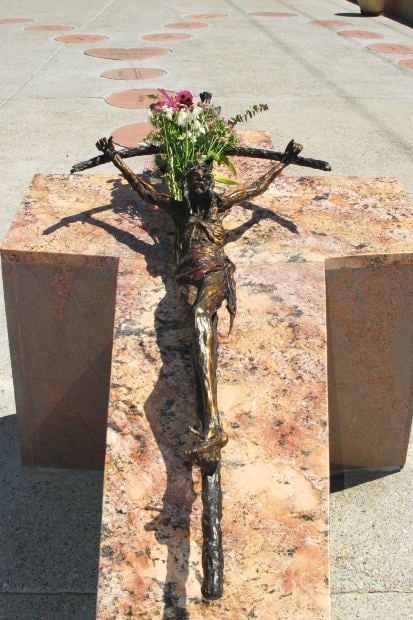There I was, on Easter Sunday, sitting at Mass with my family reading the post-Eucharist reflection in my Magnificat when it jumped out at me: Heather King had authored this reflection. Not some saint of old, but someone with whom I’ve had a real-life conversation; by email at least.
I always like these reflections but my attention was suddenly more focused. I’ve read two of Heather’s memoirs and receive her blog updates. We’ve chatted about memoir writing and other topics through email. More often than not, her writing resonates with me, and I can identify with her as a fellow modern-day Christian woman.
Even though it was Easter, Heather was fixating on the crucifixion, and I wasn’t going to stop her. The confluence of the two — Crucifixion and Resurrection — just feels right. One without the other doesn’t make any sense at all. One without the other means no Christianity.
And what would my world be without my Christian faith? Oh, woe would be me, indeed.
Now, more than any other time, perhaps, I feel deeply my gratitude for the supreme, eternal gift of this faith I’ve been given. And like Heather, even on Easter Sunday, I wasn’t done, nor will I ever be done, with the Crucifixion.
Let me allow Heather to speak:
“To over-focus on the violence of the crucifixion, however, is to miss its essential point. No violence we could re-enact could come close to the Passion of the Christ – not because we can’t imagine the violence, but because we can’t imagine Christ’s heart,” she says.
But it gets better:
“Christ doesn’t keep score, count the cost, or hold the crucifixion against us. The crucifixion was Christ’s labor, and just as no loving mother would show her child a gory video of her labor – “Look what I endured for you!” – the writers of the Gospels sketch in the outline and leave the details to our imagination.”
Now, I’m thinking back to the time I saw Mel Gibson’s Passion of the Christ. It was powerful, and I felt grateful for it, even though it was difficult to watch. I recall, the following Sunday, looking at the crucifixion at the point of the altar with new eyes and a more understanding and appreciative heart.
But as with most audio visuals, in time, the effect wears off, and it is hard to recreate in my mind the feelings I had during my viewing of the film, and in the weeks following. And at times I’ve felt like perhaps there was something wrong in that; that I needed to revisit the gore.
Here, Heather has set things right for me, and she’s done it in a way my mother heart can understand. Of course I wouldn’t force my child to watch a film of me in labor. No. I took that on by my own volition. I volunteered. They don’t need to know what it was like, really. That was my suffering and they need not have their faces rubbed in it, nor would I want that for them, or me.
Heather goes on, saying that our failure to revisit the gore in full is “neither to diminish, nor to fail to take full account of, the violence. But we don’t honor the crucifixion by feeling guilty that Christ died for our sins. We honor the crucifixion by consenting to be stripped down and to die for love ourselves.”
And there it is (emphasis mine by the way). In other words, it’s okay to feel badly Jesus went through what He did, but it’s more important that we enter into the vulnerability of it with Christ, so that we can be with Him and the Father, as is our destiny, should we comply.
I like it. It makes sense. It doesn’t get me or anyone else off the hook, but it does set things right.
Q4U: What about you? What are your feelings about the Crucifixion? What do you feel it means to “be stripped down and to die for love ourselves?”
About the Author

Roxane Salonen
Roxane B. Salonen, Fargo, North Dakota (“You betcha!”), is a wife and mother of a literal, mostly-grown handful, an award-winning children’s author and freelance writer, and a radio host, speaker, and podcaster (“ Matters of Soul Importance”). Roxane co-authored “ What Would Monica Do?” to bring hope to those bearing an all-too-common cross. Her diocesan column, “ Sidewalk Stories,” shares insights from her prolife sidewalk ministry. Visit RoxaneSalonen.com



.png?width=1806&height=731&name=CatholicMom_hcfm_logo1_pos_871c_2728c%20(002).png)
Comments